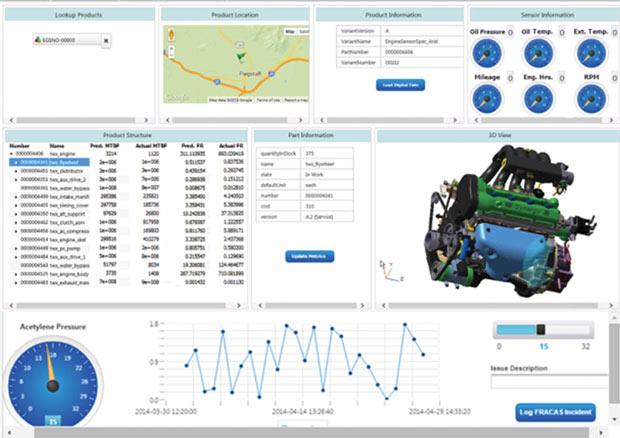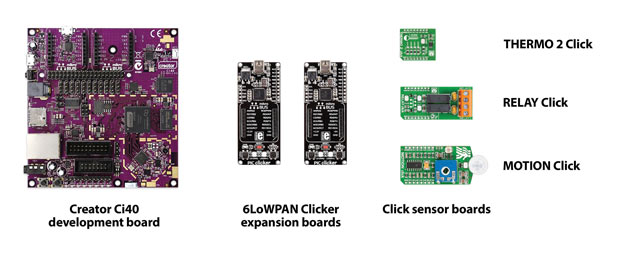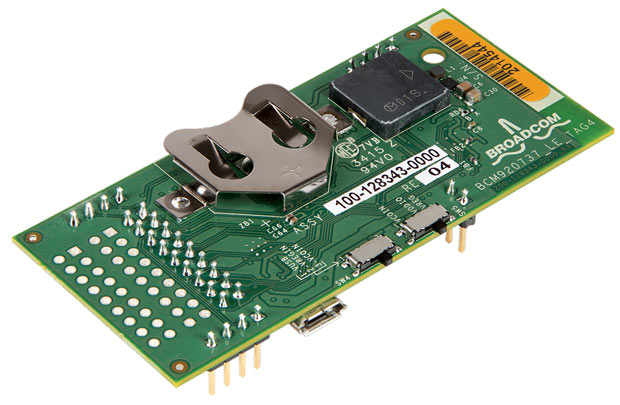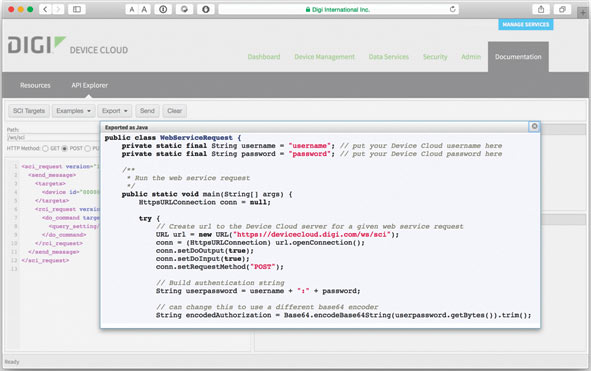
Broadcom’s WICED development system delivers Wi-Fi and Bluetooth connectivity for a range IoT applications, including home appliances and automation and logistics. Image courtesy of Broadcom.
Latest News
February 1, 2016
 Windchill 11’s mash-up capabilities will enable users to see quality data collected by products in use in the field within the context of the traditional PLM product structure.
Windchill 11’s mash-up capabilities will enable users to see quality data collected by products in use in the field within the context of the traditional PLM product structure.Image courtesy of PTC.
Even as the concept of the Internet of Things (IoT) crystalizes and so-called smart, IoT-enabled products begin to take shape, the notion of an IoT development platform remains fuzzy—primarily due to the broad sweep of functionality behind this new phase of product design.
Unlike other disciplines such as embedded software development or electronics design, there is no universally established platform like application lifecycle management (ALM) or electronics design automation (EDA) to help engineers jumpstart development efforts. Everyone from chipset and sensor manufacturers to software vendors and consortia have different definitions for what constitutes an IoT development platform—yet most are marketing these offerings as a catch-all solution for development, despite probable gaps in functionality.
The reality of today’s market, according to IoT experts, is that most current solutions only address a fraction of the wide swath of functionality required for full IoT product development, creating a host of confusion in what’s still a pretty undefined yet undoubtedly complex market.
“IoT development is a broad, diverse, and ever changing landscape,” notes Brian Bedrosian, senior director of product Marketing for Broadcom, a networking and communications electronics maker. “There are a lot of components to it—it’s a big systems engineering project to develop a cloud-connected product.”
The IoT’s Technology Stack
The full technology stack for IoT development traverses a lot of terrain. At the physical hardware level, there are the traditional 3D design and analysis tools for modeling and simulating design concepts virtually with the very important addition of sensors—specifically the need to determine the kind, sensor orientation and collection of requisite data points.
The connectivity piece, for getting sensor data to the cloud, is a major component of an IoT-enabled product and an area where many platform vendors are focused. Most provide tools to support a variety of wired and wireless connection options and in many cases, additional security and management components for safeguarding those connections.Also critical to the IoT development stack are application and user interface capabilities for designing the IoT systems that leverage data from the cloud-connected products, analytics capabilities for parsing the data for insights, and integration capabilities for syncing up with core business systems.
“Very few people talk about the complete tool chain that it takes to develop IoT apps,” says Stefan Jockusch, vice president, Strategy at Siemens PLM Software. “When most people talk about an IoT platform, they’re really referring to the integrated development environment that makes it easier and faster to gather sensor input and communicate that to a database in the cloud. However, there’s a big set of technology required in addition to that to build a complete application.”
Jockusch makes that case that traditional design tools like CAD and CAE should have equal footing in the IoT development stack, and this broader definition underscores the importance of a systems engineering approach to design. While sensor data can deliver insights into what’s happening with a product in the field, Jockusch says that data on its own is far less valuable if engineers can’t directly compare it to a virtual model of how that system was designed to work.
“The data itself in only rare cases will give you a clue of what’s happening—if something is serious and alarming or within normal design parameters,” he explains. “In order to make IoT apps meaningful and enable people to take the right action, the IoT application needs to be rationalized against a virtual representation of a product.”
That’s where CAD and simulation fit into the IoT development picture, Jockusch says, providing a “digital twin,” or virtual representation of a product, that will provide the complete picture of how design teams expect that product to work. Siemens is evolving its IoT development capabilities by leveraging the Omneo analytics tool, brought under the company’s umbrella via last year’s Camstar acquisition, as part of a systems analytics bus that will help connect data collected from products in the field to the product design data managed by Teamcenter.
“This connects the analysis you do in the CAD and CAE world to the analytics you get out of actual product so that you can get a more accurate understanding of whether what you’re measuring is within design parameters or outside,” he explains. “The key thing you’re trying to do is to extract something of business value out of the raw data to make designs and products more reliable. We see people focused on gathering the data, but the important part is to make sense of the data.”
Given the scope of the IoT development stack, interoperability will be an ongoing issue, Jockusch says. However, Siemens is mitigating those challenges by filling in pieces of its platform—its recent acquisitions of Omneo and the Polarion Application Lifecycle Management (ALM) applications are key examples—as well as better integration with other applications. “We are building a fish bone of applications that will cover the whole process, well aware that there will be many situations where customers will be using different apps and we’ll need to connect to them in the same way,” Jockush explains.
 Imagination Technologies’ Ci40 toolkit is designed as an IoT hub to help jumpstart the development of IoT-enabled prototypes. Image courtesy of Imagination Technologies.
Imagination Technologies’ Ci40 toolkit is designed as an IoT hub to help jumpstart the development of IoT-enabled prototypes. Image courtesy of Imagination Technologies.PTC, hands down the most active in IoT development, has also relied heavily on acquisition to build out a comprehensive IoT technology stack. Its ThingWorx IoT platform provides a foundation for building and deploying enterprise IoT applications; the Axeda Machine Cloud provides cloud-based services for managing, securing, and connecting products and machines; ColdLight delivers analytics and automated machine learning capabilities for gaining insights into all that raw data; and Vuforia, its latest purchase, will deliver augmented reality capabilities.
Along with its new areas of focus, PTC is infusing IoT development capabilities into its traditional design platforms, including Creo and Windchill. The company is evolving the concept of a digital twin—a broader representation of a digital product—so engineers can stay in tune with what’s happening with a specific product in the field. And the latest version of Windchill 11 includes an embedded ThingWorx adapter, which will allow the platform to connect to another “thing,” either a piece of equipment in the field or an enterprise software platform, providing engineers with even more data points and insight on which to direct design decisions.
“Because Windchill is now smart and connected, it can do things like connected quality or have a mashup of quality and product structure data in the context of the product structure,” explains Kevin Wrenn, PTC’s divisional general manager of PLM. “That lets engineers connect to real data from a piece of equipment and look at it in the context of Windchill, which will enable them to make better decisions on what to design in the next version.”
Key to Windchill’s ability to do this is new mash-up capabilities, borrowed from ThingWorx and some of its other newly acquired tools. Arena, a provider of cloud-based PLM, plans to leverage mash-up and integration capabilities to evolve its platform in a similar direction to bring IoT-type data into the engineering fold, providing teams with better design intelligence. “Say you have a product that has 10 buttons and one is used three times as much as the others, this capability would let you design in a higher quality button in the next redesign,” says Steve Chalgren, Arena’s chief strategy officer and executive vice president of Product Management. “If you don’t deliver that kind of information right to the engineer’s eyeball in the context while they’re doing work, you won’t get to make such changes as often.”
The Broader IoT Ecosystem
Beyond their traditional vendors, design engineers taking the plunge into the world of IoT will also need to expand their horizons to a broader ecosystem of platform players, especially on the connectivity front. A company like Broadcom, for example, offers the WICED connectivity platform for embedded devices, which provides secure Wi-Fi, Bluetooth, and Bluetooth Low Energy (BLE) capabilities along with security libraries, cloud connection agents, and a host of other tools, empowering engineering teams to build IoT-enabled products such as home appliances, automation equipment, smart meters and various other devices.
 Broadcom’s WICED development system delivers Wi-Fi and Bluetooth connectivity for a range IoT applications, including home appliances and automation and logistics. Image courtesy of Broadcom.
Broadcom’s WICED development system delivers Wi-Fi and Bluetooth connectivity for a range IoT applications, including home appliances and automation and logistics. Image courtesy of Broadcom.For Broadcom, partnerships will be key to building out its IoT platform and development strategy. “To accomplish our goal of providing end-to-end services, we choose to align with an ecosystem of partner companies that will provide all the services that are outside of our area of expertise,” Bedrosian says. “Industrial companies might make great electromechanical systems like heat pumps while semiconductor guys like us are not as proficient at that, but do robust networking. We will focus on our core competency and use our partner network to provide the other components.”
Digi International is also cultivating an ecosystem and opening up its Device Cloud APIs (application programming interfaces) to ensure its M2M (machine-to-machine) connectivity solutions integrate seamlessly in a larger IoT technology stack. “There’s no way one company is ruling IoT all by itself—it’s too complicated and too interesting,” says Rob Faludi, Digi’s chief innovator.
 The Digi Device Cloud’s support for open APIs positions the platform as part of a broader ecosystem for IoT development. Image courtesy of Digi.
The Digi Device Cloud’s support for open APIs positions the platform as part of a broader ecosystem for IoT development. Image courtesy of Digi.Imagination Technologies, on the other hand, is taking a completely different approach, offering up a soup-to-nuts starter IoT development platform that targets engineers just starting out on the IoT journey, who are looking for a way to fast-track design of early prototypes. The Ci40, geared toward smaller enterprises or entrepreneurs, is billed as an “IoT hub,” and includes sensors; MIPS-powered boards that incorporate memory, security capabilities, and a range of wireless standards from Bluetooth to ZigBee; along with cloud connectivity; among other features.
“Because IoT [development] is so broad, it requires a lot of different skill sets and engineering disciplines that smaller companies may not have,” explains Paul Evans, business development director for Imagination Technologies. “The kit has something from each discipline so companies can get started building a prototype or putting products into low-volume production.”
Even while IoT opens the door to new areas and companies outside of the traditional design engineer domain, experts say core systems like PLM will remain essential to the design of smart connected products. “IoT provides a connection point to bring business value to customers, and PLM is a key part of that,” explains Matt Sheridan, PTC’s director of PLM. “It provides the opportunity to take information coming from the design world and leverage it across a product’s whole lifecycle.”
More Info:
Subscribe to our FREE magazine, FREE email newsletters or both!
Latest News
About the Author
Beth Stackpole is a contributing editor to Digital Engineering. Send e-mail about this article to [email protected].
Follow DE





